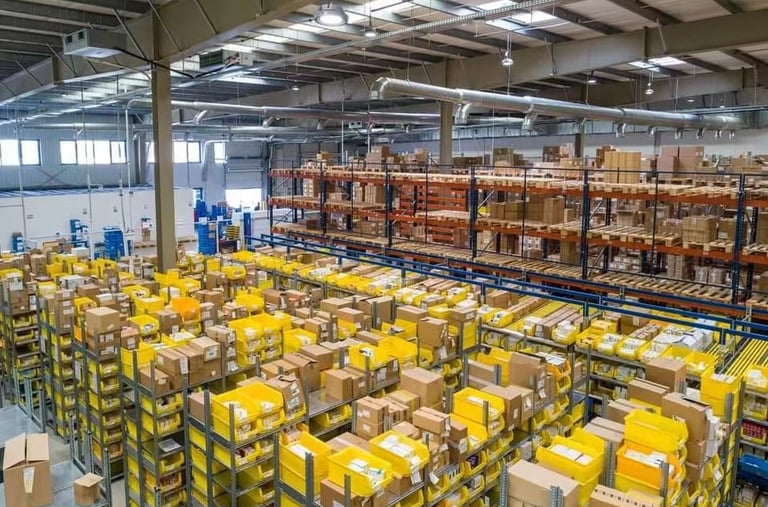Optimizing Inventory Management: Choosing Between Warehouses and Fulfillment Centers
SOURCING AGENT
5/15/20243 min read


In the world of logistics and supply chain management, choosing the right storage solution can significantly impact the efficiency and success of your business operations. Two primary options that businesses often consider are traditional warehouses and modern fulfillment centers. Each serves a distinct purpose and comes with its own set of advantages and challenges. In this comprehensive guide, we'll delve deep into the differences between warehouses and fulfillment centers, exploring their suitability for short-term and long-term storage, inventory monitoring capabilities, technological integration, supply chain efficiency, shipping speed, and overall cost considerations.
Warehouse Basics:
Warehouses have long been the cornerstone of supply chain logistics. They are dedicated spaces designed for the storage of goods over extended periods, ranging from several months to several years. Warehouses are characterized by their static nature, serving as hubs for inventory consolidation, storage, and distribution. Traditionally, warehouses rely on manual processes for inventory monitoring, with periodic physical counts to track stock levels. However, modern warehouses are increasingly adopting RFID (Radio Frequency Identification) technology and automated system integration to enhance efficiency and accuracy in inventory management.
Fulfillment Centers:
In contrast to warehouses, fulfillment centers are dynamic facilities optimized for short-term storage and rapid order fulfillment. Fulfillment centers are strategically located close to consumer populations to enable fast shipping and delivery. These centers are designed to handle high volumes of incoming and outgoing inventory, with a focus on streamlined processing and order automation. Fulfillment centers leverage cutting-edge technology, including RFID tracking, automated picking systems, and real-time inventory management software, to ensure accurate and efficient order fulfillment.
Warehouse vs. Fulfillment Center:
The choice between a warehouse and a fulfillment center largely depends on your business needs and objectives. For businesses requiring long-term storage solutions and bulk inventory management, warehouses offer cost-effective options. Warehouses are ideal for storing goods that have low turnover rates or seasonal demand patterns. They provide flexibility in storage and allow businesses to maintain control over their inventory over extended periods.
On the other hand, fulfillment centers excel in meeting the demands of e-commerce and direct-to-consumer (DTC) businesses that prioritize speed and agility in order fulfillment. Fulfillment centers are particularly beneficial for businesses with high inventory turnover rates, enabling rapid processing of incoming orders and same-day or next-day delivery to customers. The proximity of fulfillment centers to end consumers minimizes shipping distances and reduces transit times, resulting in improved customer satisfaction and retention.
Short-Term Storage vs. Long-Term Storage:
When considering storage duration, fulfillment centers are ideally suited for short-term storage needs. These facilities are optimized for quick inventory turnover and are not designed for prolonged storage of goods. In contrast, warehouses are better equipped to handle long-term storage requirements, offering secure and cost-effective storage solutions for inventory that does not require frequent access.
Inventory Monitoring and Technological Integration:
Both warehouses and fulfillment centers leverage technology to monitor inventory and streamline operations. Warehouses are increasingly adopting RFID technology and automated inventory management systems to enhance accuracy and efficiency. However, fulfillment centers lead in terms of real-time inventory visibility and automated order processing, thanks to advanced technological integration.
Supply Chain Efficiency and Shipping Speed:
Fulfillment centers play a pivotal role in optimizing supply chain efficiency by reducing transit times and shipping distances. The proximity of fulfillment centers to end consumers enables expedited shipping and same-day delivery options, enhancing overall customer experience. In contrast, warehouses contribute to supply chain efficiency by providing centralized storage hubs and enabling bulk shipments to regional distribution centers.
Cost Considerations and Flexibility:
Cost considerations play a crucial role in determining the optimal storage solution for your business. Fulfillment centers typically involve higher operational costs due to their advanced technology and rapid order processing capabilities. However, these costs are offset by increased efficiency and reduced shipping expenses. Warehouses offer cost-effective long-term storage options but may lack the flexibility and speed of fulfillment centers.
Conclusion:
In conclusion, the choice between warehouses and fulfillment centers depends on the specific requirements and priorities of your business. For businesses focused on long-term storage and bulk inventory management, warehouses provide cost-effective solutions. Conversely, fulfillment centers are ideal for businesses prioritizing speed, agility, and customer satisfaction in order fulfillment. By understanding the differences and capabilities of each storage solution, you can optimize your inventory management practices and enhance overall supply chain efficiency.
Incorporating the right storage solution into your logistics strategy can drive growth, improve operational efficiency, and elevate the customer experience. Whether you opt for a traditional warehouse or a state-of-the-art fulfillment center, choosing the right storage solution is a strategic decision that can propel your business towards success in today's competitive marketplace.
